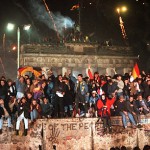Recovering Europe's Past
 My latest column for The Week looks at Eastern Europe's recovery from the destruction of World War II and the deformation of the Cold War.
My latest column for The Week looks at Eastern Europe's recovery from the destruction of World War II and the deformation of the Cold War.
My latest column for The Week looks at Europe's recovery from World War II and the Cold War.
I last visited Berlin 20 years ago, in the summer of 1990. My wife and I traveled through newly ex-communist Poland, Hungary, both halves of the soon to be disunited Czechoslovakia, and East Germany. I extracted my own paint-tinted block from the still standing Berlin Wall with a hammer and chisel.
Back then, Berlin was two cities with a kill-zone in between. We visited the east during the day, but spent our nights in the west: At the mid-point of the trip, after having gone two long weeks without a decent cup of coffee, with two weeks more to go, a respite of capitalist indulgence seemed called for.
Berlin remains two cities. Those with money to spend continue to live well west of the dismantled Wall, in comfortable-to-grand wooded suburbs. To the far east of the wall are the grittier residential neighborhoods of the former east, ringed by the grim high-rises of the Communist-built satellite cities. Between middle-class Dahlem in the west and skinhead Hellersdorf in the east stretches a distance of almost 30 kilometers.
About midway between these extremities, what was once empty central Berlin has been rebuilt into a curious new tourist town, crammed with museums, government buildings, office towers, gleaming embassies, restaurants and hotels: everything for which a city could wish, except for actual residents. Whole streetscapes have been rebuilt, an amazing new infrastructure summoned to life. Walk those streets after closing time, and your footsteps will be your only company.
The achievement is no less amazing for being incomplete. Postwar reconstruction takes time, and Berlin is reconstructing from two wars at once: the destruction of World War II and the deformation of the Cold War.
Click here to read more.